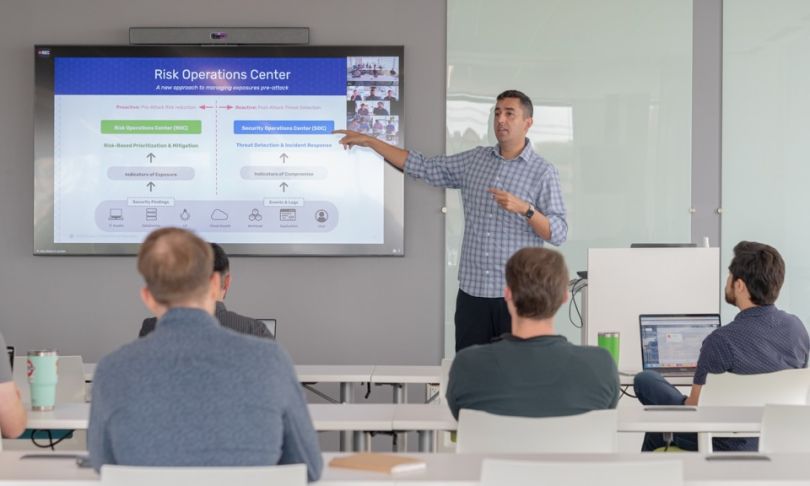What’s the point of a North Star if no one can agree on its location?
For the explorers of long ago who used the night sky to guide them along their journeys, it was a shared point of reference. Without a reliable, tangible compass, chaos, uncertainty and miscommunication would have ensued.
Nowadays, GPS and detailed maps exist. Still, the concept of the North Star remains as true now as it was then. Without shared goals, values and missions, team members find themselves lost and frustrated while working toward collective success.
In professional settings, where individual skills and team functions carefully fit into the broader puzzle, it’s vital to have a shared roadmap and compass.
At Brinqa, a centralized platform that mitigates cybersecurity vulnerabilities, commonalities are as important as unique skills.
“We firmly believe in setting shared, cross-functional goals for the involved teams and frequently communicating the ‘why’ behind the project,” explained Senior VP of Product Management Mayuresh Ektare. “When the teams are firing on all cylinders, the shared purpose becomes the crankshaft that binds them together for the cross-functional alignment.”
“When teams are firing on all cylinders, the shared purpose becomes the crankshaft that binds them together for cross-functional alignment.”
For Ektare, alignment must extend beyond his own team as he works with those like Director of Product Marketing Alex Babar, who attends product-development meetings to stay updated on pertinent information.
“The product team has dedicated some resources for market research and deal generation in marketing. In short, there’s already a culture of collaboration at Brinqa that helps us work more efficiently, and having that culture in place will help us as we scale,” said Babar.
While few would disagree that ‘teamwork makes the dream work,’ effective collaboration is founded on purposeful efforts and awareness — and it’s rarer than one might think.
In an academic study of 95 teams at 25 leading corporations, 75 percent of teams were deemed dysfunctional — either lacking clarity of goals, unable to meet expectations or misaligned with corporate goals. Another study by Fierce, Inc., revealed that 86 percent of those surveyed said ineffective communication and lack of collaboration were to blame for workplace failures.
According to Ektare and Babar, Brinqa’s positive work culture emphasizing respect, empathy and recognition creates a domino effect that cascades to collective success.
“When team members feel valued, they are more likely to work well together. When team members identify with the team’s goals and values, they are more likely to collaborate effectively to achieve common objectives,” said Chief Customer Officer Gopal Nagarajan.
He added, “When culture and collaboration align, teams can achieve higher levels of productivity and innovation.”
Built In sat down with Ektare, Babar and Nagarajan to discover the secret to Brinqa’s successful alignment and collaboration.
In your role, how do you help build a foundation for strong collaboration, communication and alignment?
Ektare: Product management is often the glue that binds many functions: engineering, design, customer success, sales, marketing and more. A strong product management team facilitates and accelerates the organization’s decision-making process and generally eliminates uncertainty so the teams have a common understanding of the objective and a shared definition of success.

Nagarajan: My role is a bridge between various departments, encouraging open communication and information sharing. Our department is also responsible for analyzing customer data and feedback and disseminating valuable insights across departments. A shared understanding of customer preferences and pain points helps teams align their efforts toward better customer experiences.
“A shared understanding of customer preferences and pain points helps teams align their efforts toward better customer experiences.”
Babar: I focus on improving the interaction between marketing and sales. Once they’re aligned well, we then connect with the product team. After successfully integrating these three units, we can finally expand our scope to include customer success. This step-by-step method allows us to build strong cross-functional relationships without excluding any group during the process.

What’s a key strategy you employ as a leader to create alignment and build good working relationships across teams?
Ektare: Product management is all about collaboration and alignment. The word “over communication” simply does not exist in the PM’s vocabulary. To build strong relationships and alignment, it is essential to describe in detail the decision-making process behind our strategies. We often lean towards articulating a data-backed rationale to explain the strategy. Storytelling is one of the key skill sets for an effective PM.
Babar: My main strategy is respect, coupled with empathy. Understanding each department helps build strong relationships and aligns our goals. Though, at the end of the day, it all comes down to one thing: people love supporting a winner. If we can make our business win financially then everything else falls into place.

Different teams bring different perspectives to the work they do. What have you done to better understand and learn from your colleagues on other teams?
Babar: Interacting regularly with different departments reveals patterns in thinking and areas they may overlook on their own. For instance, an engineer might aim for a comprehensive solution while someone from sales might prefer quick results that work for now. Neither approach is right or wrong; it’s more about making decisions based on the situation.
“Interacting regularly with different departments reveals patterns in thinking and areas they may overlook on their own.”
Nagarajan: One of the most successful programs at our company is a weekly session with an invited speaker that transfers knowledge of a particular topic of current interest. The presentation draws questions and discussions from across the company, lending itself to the spontaneous exchange of ideas and thoughts.
We have noticed that showcasing knowledge by one function encourages colleagues from another to reciprocate. We have also facilitated job swaps among technical roles. Hands-on experience gives one a first-hand understanding of the other’s challenges and responsibilities.








